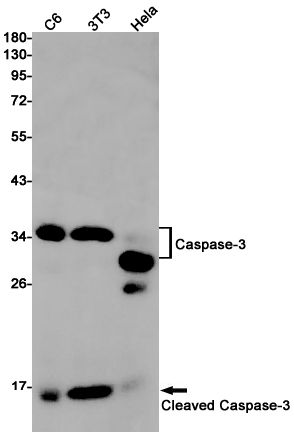
| WB | 咨询技术 | Human,Mouse,Rat |
| IF | 咨询技术 | Human,Mouse,Rat |
| IHC | 咨询技术 | Human,Mouse,Rat |
| ICC | 技术咨询 | Human,Mouse,Rat |
| FCM | 咨询技术 | Human,Mouse,Rat |
| Elisa | 咨询技术 | Human,Mouse,Rat |
| Aliases | CASP3; CPP32; Caspase-3; CASP-3; Apopain; Cysteine protease CPP32; CPP-32; Protein Yama; SREBP cleavage activity 1; SCA-1 |
| Entrez GeneID | 836 |
| WB Predicted band size | Calculated MW: 32 kDa; Observed MW: 32,17 kDa |
| Host/Isotype | Rabbit IgG |
| Antibody Type | Primary antibody |
| Storage | Store at 4°C short term. Aliquot and store at -20°C long term. Avoid freeze/thaw cycles. |
| Species Reactivity | Human,Mouse,Rat |
| Immunogen | A synthetic peptide of Caspase-3 |
| Formulation | Purified antibody in TBS with 0.05% sodium azide,0.05%BSA and 50% glycerol. |
+ +
以下是关于Cleaved-Caspase 3 p17抗体的3篇参考文献及其摘要内容:
1. **文献名称**:*Caspase-3 is the primary activator of apoptotic DNA fragmentation via DNA fragmentation factor (DFF)*
**作者**:Porter, A.G., & Jänicke, R.U.
**摘要**:该研究阐明了Caspase-3在凋亡过程中切割DNA的关键作用,通过激活DFF蛋白导致DNA断裂。文中使用Cleaved-Caspase 3 p17抗体验证了Caspase-3的活化形式,确认其在凋亡信号通路中的核心地位。
2. **文献名称**:*Specificity of anti-caspase antibodies in living cells*
**作者**:Riedl, S.J., et al.
**摘要**:研究比较了多种Caspase抗体的特异性,包括Cleaved-Caspase 3 p17抗体。通过免疫印迹和流式细胞术,证实该抗体仅识别活化后的Caspase-3 p17片段,为凋亡检测提供了可靠工具。
3. **文献名称**:*Chemotherapy-induced apoptosis in breast cancer cells is mediated by caspase-3 activation*
**作者**:Sellers, K., et al.
**摘要**:探讨化疗药物诱导乳腺癌细胞凋亡的机制,通过Cleaved-Caspase 3 p17抗体检测到活化Caspase-3的显著上调,表明其作为凋亡标志物在治疗评估中的应用价值。
4. **文献名称**:*Caspase-3 activation in Alzheimer’s disease brain correlates with amyloid-beta levels*
**作者**:Troy, C.M., et al.
**摘要**:研究阿尔茨海默病小鼠模型中Caspase-3的激活与β-淀粉样蛋白沉积的关系。利用Cleaved-Caspase 3 p17抗体发现神经元凋亡与病理进展密切相关,提示其在神经退行性疾病中的作用。
这些文献涵盖了该抗体的机制验证、特异性分析及在癌症与神经科学中的应用场景。
Cleaved-Caspase 3 p17 antibody is a critical tool for detecting apoptosis, a programmed cell death process essential for development and tissue homeostasis. Caspase-3. a member of the cysteine-aspartic acid protease (caspase) family, exists as an inactive zymogen (pro-caspase-3) in living cells. During apoptosis, upstream signals activate initiator caspases (e.g., caspase-8 or -9), which cleave pro-caspase-3 into active fragments: a p17 subunit (17 kDa) and a p12 subunit (12 kDa). The p17 fragment is a hallmark of caspase-3 activation and serves as a definitive marker for apoptotic cells.
This antibody specifically recognizes the cleaved p17 subunit, enabling researchers to distinguish active caspase-3 from its inactive precursor. It is widely used in techniques like Western blotting, immunohistochemistry (IHC), and flow cytometry to assess apoptosis in diverse contexts, including cancer research, neurodegenerative disease studies, and drug development. For instance, elevated cleaved caspase-3 p17 levels indicate therapeutic efficacy in cancer treatments targeting apoptosis pathways.
Sample preparation is crucial, as cleaved caspase-3 is transient and may require controlled conditions (e.g., avoiding protease degradation or optimizing fixation methods). The antibody’s specificity for the cleaved form minimizes cross-reactivity with full-length caspase-3. ensuring accurate detection. Its utility in both preclinical and clinical research underscores its importance in understanding apoptotic mechanisms and evaluating interventions that modulate cell survival.
×